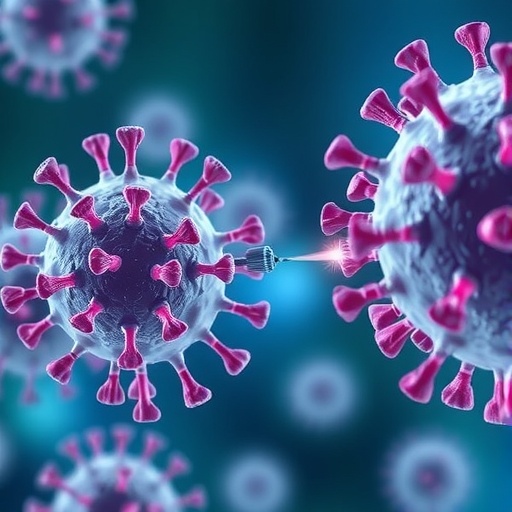A groundbreaking discovery in the field of antiviral therapy has emerged from Hiroshima University, highlighting the potential of a new class of inhibitors targeting the enzyme peptidyl-prolyl cis-trans isomerase NIMA-interacting 1, commonly referred to as Pin1. This enzyme has been identified as a pivotal host factor exploited by herpes simplex virus type 1 (HSV-1) to facilitate its replication and egress. The recent study, published in the revered journal Antiviral Research, elucidates how Pin1 inhibitors thwart the viral life cycle, offering a promising therapeutic avenue for managing HSV-1 infections, which are pervasive globally.
HSV-1 is the primary causative agent behind oral herpes, manifesting as cold sores or fever blisters around the mouth. The virus is extraordinarily common, with infection rates spanning from 50% to 90% worldwide, typically acquired during childhood. Upon initial infection, HSV-1 establishes latency within the host, capable of reactivation throughout life. While these infections are generally benign in immunocompetent individuals, they pose severe risks in immunocompromised patients, occasionally leading to life-threatening complications. Therefore, innovative antiviral strategies are crucial to mitigate these recurrent episodes and their potential severity.
Pin1, a peptidyl-prolyl cis-trans isomerase, serves as a molecular switch influencing protein conformation, stability, and function within cells. It orchestrates several cellular processes and structural configurations that viruses hijack to optimize their replication. Aberrations in Pin1 activity are implicated in diverse pathologies, including cancer, obesity, and heart diseases. Its role in viral infections has gained attention recently, especially with viruses like cytomegalovirus and SARS-CoV-2 manipulating Pin1 activity to enhance their proliferative efficiency. This prior knowledge paved the way for investigations into the applicability of Pin1 inhibitors against HSV-1.
The research team employed both the known inhibitor H-77 and four novel Pin1 inhibitors synthesized specifically for this study. Using VeroE6 cells, a canonical in vitro model derived from African green monkey kidneys widely utilized in virology, the investigators infected these cells with HSV-1 and administered increasing concentrations of Pin1 inhibitors. Remarkably, even sub-micromolar concentrations exhibited significant suppression of viral replication. At 1 micromolar concentration, viral effects on host cells were virtually extinguished, suggesting a potent inhibitory effect.
Mechanistically, the study revealed that Pin1 inhibitors act by reinforcing the nuclear lamina, a structural barrier surrounding the nucleus, which herpesviruses must traverse to disseminate progeny virions. Normally, HSV-1 overexpresses Pin1 to dismantle this nuclear barrier, facilitating nucleocapsid egress. However, the application of H-77 counteracts this by stabilizing the nuclear membrane, converting it into an ‘impregnable defensive wall’ that physically entraps the virus within the nucleus. This biophysical constraint prevents viral particles from reaching the cytoplasm and subsequently budding off as infectious agents.
Infection assays demonstrated that any virions released from treated cells lacked infectivity, underscoring the functional incapacity imposed by Pin1 inhibition. Such a physical blockade not only halts the spread of infection but also impairs the synthesis of viral proteins, effectively crippling the viral replication machinery. Thus, the antiviral effect is dual-faceted: inhibition of viral protein production and prevention of viral egress.
The implications for clinical application are profound. Pin1 inhibitors represent a form of ‘host-directed therapy,’ which targets cellular pathways co-opted by viruses rather than the viruses themselves. This approach significantly reduces the likelihood of resistance development, a major challenge confronting current antiviral treatments. Considering the widespread prevalence of HSV-1 and the limitations of existing therapies, Pin1 inhibitors could revolutionize the therapeutic landscape.
Future investigations will focus on comprehensive efficacy evaluations of Pin1 inhibitors across a broad spectrum of viral pathogens. Given the enzyme’s involvement in various viral replication cycles, there is a tantalizing prospect that these inhibitors may possess broad-spectrum antiviral properties. Concurrently, optimization of the chemical structures of these compounds is underway, aiming to enhance potency, selectivity, and pharmacological profiles suitable for clinical use.
The structural stabilization of the nuclear lamina presents an exciting therapeutic mechanism with potential applications beyond antiviral therapy. Understanding how modulation of nuclear architecture affects viral dynamics can unlock new paradigms in cell biology and virology. This knowledge can also contribute to developing novel strategies against other pathogens that exploit nuclear egress pathways.
This study, led by Professor Takemasa Sakaguchi at Hiroshima University’s Graduate School of Biomedical and Health Sciences, signifies a major advancement in the fight against herpes simplex virus 1. The collaborative effort included multidisciplinary teams from Hiroshima University, Amenis Bioscience, Inc., and The University of Tokyo, supported by significant funding from Japanese medical and scientific agencies. Their findings lay a robust foundation for future clinical development and underscore the importance of targeting host factors in antiviral research.
As HSV-1 remains a global public health concern due to its ubiquity, persistence, and potential severity, innovative therapeutic strategies are urgently needed. Pin1 inhibitors herald a new class of antivirals that offer hope for effective management and possibly prevention of recurrent HSV-1 infections. The prospect that these inhibitors could extend their efficacy to other viral diseases posits an exciting horizon for antiviral medicine, promising reduced drug resistance and improved patient outcomes.
In summary, the discovery of Pin1 inhibitors as potent suppressors of HSV-1 replication presents a novel and sophisticated antiviral mechanism. By stabilizing the nuclear lamina and preventing viral egress, these compounds incapacitate the virus effectively at clinically attainable concentrations. Continued research is poised to expand their application and refine their pharmacological characteristics, potentially transforming viral therapeutics in the near future.
Subject of Research: Antiviral therapy targeting the host enzyme Pin1 to suppress herpes simplex virus type 1 replication.
Article Title: Suppression of herpes simplex virus type 1 replication by Pin1 inhibitors: insights from H-77 and novel compounds
News Publication Date: 25-Jul-2025
Web References:
- https://www.sciencedirect.com/science/article/pii/S0166354225001706?via%3Dihub=
- http://dx.doi.org/10.1016/j.antiviral.2025.106244
Image Credits: Takemasa Sakaguchi, Hiroshima University
Keywords: Herpes simplex, Pin1 inhibitors, HSV-1 replication, antiviral therapy, nuclear lamina stabilization, host-directed therapeutics, virology, molecular biology, cell biology




